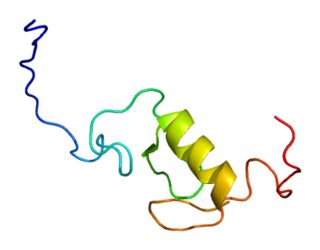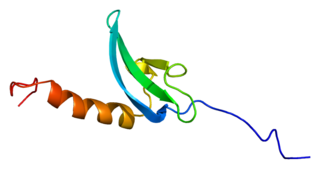E3 ubiquitin-protein ligase RING1 is an enzyme that in humans is encoded by the RING1 gene. [5] [6]
E3 ubiquitin-protein ligase RING1 is an enzyme that in humans is encoded by the RING1 gene. [5] [6]
This gene belongs to the RING finger family, members of which encode proteins characterized by a RING domain, a zinc-binding motif related to the zinc finger domain. The gene product can bind DNA and can act as a transcriptional repressor. It is associated with the multimeric polycomb group protein complex. The gene product interacts with the polycomb group proteins BMI1, EDR1, and CBX4, and colocalizes with these proteins in large nuclear domains. It interacts with the CBX4 protein via its glycine-rich C-terminal domain. The gene maps to the HLA class II region, where it is contiguous with the RING finger genes FABGL and HKE4. [6]
RING1 has been shown to interact with CBX8, [7] BMI1 [8] [9] and RYBP. [10] [11]
Polycomb-group proteins are a family of protein complexes first discovered in fruit flies that can remodel chromatin such that epigenetic silencing of genes takes place. Polycomb-group proteins are well known for silencing Hox genes through modulation of chromatin structure during embryonic development in fruit flies. They derive their name from the fact that the first sign of a decrease in PcG function is often a homeotic transformation of posterior legs towards anterior legs, which have a characteristic comb-like set of bristles.

Histone deacetylase 1 (HDAC1) is an enzyme that in humans is encoded by the HDAC1 gene.

Polycomb complex protein BMI-1 also known as polycomb group RING finger protein 4 (PCGF4) or RING finger protein 51 (RNF51) is a protein that in humans is encoded by the BMI1 gene. BMI1 is a polycomb ring finger oncogene.

Tripartite motif-containing 28 (TRIM28), also known as transcriptional intermediary factor 1β (TIF1β) and KAP1, is a protein that in humans is encoded by the TRIM28 gene.

C-terminal-binding protein 1 also known as CtBP1 is a protein that in humans is encoded by the CTBP1 gene. CtBP1 is one of two CtBP proteins, the other protein being CtBP2.

YY1 is a transcriptional repressor protein in humans that is encoded by the YY1 gene.

Zinc finger protein 148 is a protein that in humans is encoded by the ZNF148 gene.

Alpha-globin transcription factor CP2 is a protein that in humans is encoded by the TFCP2 gene.

E3 ubiquitin-protein ligase RING2 is an enzyme that in humans is encoded by the RNF2 gene.

Polycomb protein EED is a protein that in humans is encoded by the EED gene.

Polyhomeotic-like protein 1 is a protein that in humans is encoded by the PHC1 gene.

Polycomb group RING finger protein 2, PCGF2, also known as MEL18 or RNF110, is a protein that in humans is encoded by the PCGF2 gene.

Polyhomeotic-like protein 2 is a protein that in humans is encoded by the PHC2 gene.

RING1 and YY1-binding protein is a protein that in humans is encoded by the RYBP gene.

Polycomb group RING finger protein 6 is a protein that in humans is encoded by the PCGF6 gene.

Chromobox protein homolog 8 is a protein that in humans is encoded by the CBX8 gene.

Chromobox protein homolog 2 is a protein that in humans is encoded by the CBX2 gene. According to a New Scientist article CBX2 controls human sex even more so than X/Y chromosomes.

Polycomb group RING finger protein 1, PCGF1, also known as NSPC1 or RNF68 is a RING finger domain protein that in humans is encoded by the PCGF1 gene.
M33 is a gene. It is a mammalian homologue of Drosophila Polycomb. It localises to euchromatin within interphase nuclei, but it is enriched within the centromeric heterochromatin of metaphase chromosomes. In mice, the official symbol of M33 gene styled Cbx2 and the official name chromobox 2 are maintained by the MGI. Also known as pc; MOD2. In human ortholog CBX2, synonyms CDCA6, M33, SRXY5 from orthology source HGNC. M33 was isolated by means of the structural similarity of its chromodomain. It contains a region of homology shared by Xenopus and Drosophila in the fifth exon. Polycomb genes in Drosophila mediate changes in higher-order chromatin structure to maintain the repressed state of developmentally regulated genes. M33 deficiency interferes with steps upstream of the Y-chromosome-specific SRY gene may cause sex reversal. It may also involved in the campomelic syndrome and neoplastic disorders linked to allele loss in this region. Disruption of the murine M33 gene, displayed posterior transformation of the sternal ribs and vertebral columns.

The human KDM2B gene encodes the protein lysine (K)-specific demethylase 2B.
This article incorporates text from the United States National Library of Medicine, which is in the public domain.